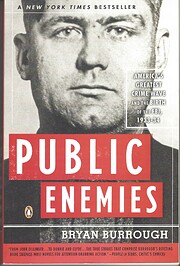

Auf ein Miniaturbild klicken, um zu Google Books zu gelangen.
|
Lädt ... Public Enemies: America's Greatest Crime Wave and the Birth of the FBI, 1933-34 (Original 2004; 2005. Auflage)von Bryan Burrough
Werk-InformationenPublic Enemies: America's Greatest Crime Wave and the Birth of the FBI, 1933-34 von Bryan Burrough (2004)
 Keine Keine aktuelle Diskussion zu diesem Buch. Bryan Burrough's book, "Public Enemies" tells the stories of the most significant criminals and bank robbers in the United Stated during the Depression Era. His book also makes the case that the need for more coordinated investigations and prosecutions of these criminals led to the strengthening of the Justice Department's Bureau of Investigation, and it becoming the newly named Federal Bureau of Investigation (FBI) with J. Edgar Hoover as it's head. While a recent (2017) popular book "Killers of the Flower Moon", makes a related and somewhat contradictory claim about the birth of the FBI, instead crediting the government investigation of murders on the Osage indian Reservation in Oklahoma that led to the FBI's birth, perhaps both events were equally important. In any case, Burrough's supports his case quite nicely in "Public Enemies", and it is interesting to read of how the Agency evolved from it's earliest years to the modern investigative power house of today. Burroughs book covers the criminal names many of us have heard of from the past, including Bonnie and Clyde, Baby Face Nelson, Machine Gun Kelly, Pretty Boy Floyd, John Dillinger, and the Barker gang. Most of these gangsters were active around the same time, and it's informative to hear about the advantages they had in their crime sprees because of their access to fast cars and automatic weapons, especially in contrast to the resources of the weak local police forces tasked with stopping them. Ultimately, the FBI was strengthened to have jurisdiction in cases which crossed state lines and given the needed additional resources and expertise. How the crime sprees took place, and how local and Federal crime fighting forces worked to bring these criminals to justice was an interesting story. Crime. That's a theme in the books that I have been reading this year. Atwood's Alias Grace, crime novel. Choke? Definitely has seedy elements that should be crimes. American Psycho, check. Maltese Falcon, check. Anyway, sometimes it's interested to examine the types of books that you read. :) This book was great. I will say that while I was reading this, I knew it was going to be a movie with my fav actor, Johnny Depp, and that might have influenced my feelings for the book. But to look at why this is a good novel. It is a very well-researched novel, but it doesn't read like an essay paper. It is engaging. I found myself wanting to read more, and more, until I finished this beast of a book. One of the most interesting things that Burrough does is that he takes these crimes and puts them into context. While Dillinger was robbing a bank, the Barker Gang was _________. It's interesting. He also puts into context globally. Like Hitler was using all of these criminals s an example for why Germany should sterilize criminals (so they can't breed more criminals). Burrough also reminds us that these crimes were happening at a time when most Americans were suffering harshly from the effects of the Great Depression. And I had never thought about these criminals in that sense before. A good read. PS. When he was talking about Baby Face Nelson....who hung out a lot in Nevada--well, I knew all the small towns he hung out. :) keine Rezensionen | Rezension hinzufügen
Bearbeitet/umgesetzt inPrestigeträchtige Auswahlen
History.
Nonfiction.
HTML:The astonishing true story of America's first and greatest "War on Crime." In Public Enemies, Bryan Burrough strips away a thick layer of myths put out by J. Edgar Hoover's FBI to tell the full story of the most spectacular crime wave in American history, the two-year battle between the young Hoover and an assortment of criminals who became national icons: John Dillinger, Machine Gun Kelly, Bonnie and Clyde, Baby Face Nelson, Pretty Boy Floyd, and the Barkers. In 1933, police jurisdictions ended at state lines, the FBI was in its infancy, and fast cars and machine guns were easily available. It was a great time to be a bank robber. On hand were a motley crew of criminal masterminds, sociopaths, romantics, and cretins. Bryan Burrough has unearthed an extraordinary amount of new material on all the major figures involved -- revealing many fascinating interconnections in the vast underworld ecosystem that stretched from Texas up to Minnesota. But the real-life connections were insignificant next to the sense of connectedness J. Edgar Hoover worked to create in the mind of the American public-using the "Great Crime Wave" to gain the position of untouchable power he would occupy for almost half a century. .Keine Bibliotheksbeschreibungen gefunden. |
Aktuelle DiskussionenKeineBeliebte Umschlagbilder
 Google Books — Lädt ... Google Books — Lädt ...GenresMelvil Decimal System (DDC)364.97309043Social sciences Social problems and services; associations Criminology Biography And History North America United StatesKlassifikation der Library of Congress [LCC] (USA)BewertungDurchschnitt: (3.92) (3.92)
Bist das du?Werde ein LibraryThing-Autor. |
||||||||||||||||||||||||||||||||||||||||||||||||||||||||||||||||||||||||||||||||||||||||||||||||||||||||||||||||||||||||||||||||||||||
I didn’t realize all those gangs were active at the same time. (